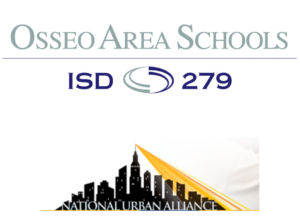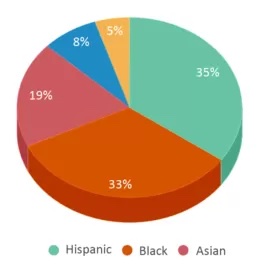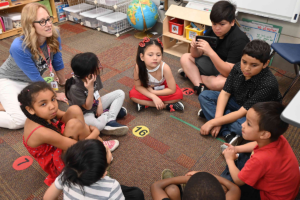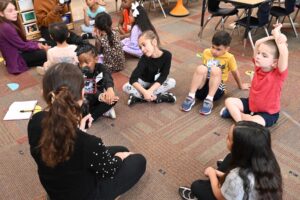Whole School Change Collaboration
A Model in Action – 2023
The Fair Oaks Elementary School Leadership Team, June 2023
Sara Looby, Jeffrey Aronow, Doris Lemenski
Osseo Area Schools, MN
Fair Oaks Elementary is a Title I school serving approximately 360 pre-k through fifth grade students in Brooklyn Park, Minnesota. Asian, Hispanic, and Black students each comprise about one-third of the student population, with around 84% qualifying for free and reduced lunch. Nearly 40% of our students are English Language Learners, speaking primarily Spanish, and close to 20% of our students have qualified for Special Education.
 “Our partnership with Robert Price and the National Urban Alliance over the past three years has been pivotal in developing sustainability with the High Operational Practices that are embedded throughout our curriculum and daily routines. Fair Oaks staff have been on an NUA journey that began with a monthly cohort to both examine and increase our capacity to ensure equitable learning experiences for all students. However, it wasn’t until Robert led the cohort in the spring of 2020 that our teachers began to fully understand the impact of integrating culturally responsive instruction. While remote learning brought many challenges, it also created the impetus to reframe how we provide professional development, especially as it pertained to utilizing our time with Robert. Our cohort no longer consisted of one teacher representative from each grade level, but rather, we moved to a schoolwide model involving all teachers receiving NUA training. Our non-licensed support staff have participated in ongoing professional development facilitated by Robert as well.
“Our partnership with Robert Price and the National Urban Alliance over the past three years has been pivotal in developing sustainability with the High Operational Practices that are embedded throughout our curriculum and daily routines. Fair Oaks staff have been on an NUA journey that began with a monthly cohort to both examine and increase our capacity to ensure equitable learning experiences for all students. However, it wasn’t until Robert led the cohort in the spring of 2020 that our teachers began to fully understand the impact of integrating culturally responsive instruction. While remote learning brought many challenges, it also created the impetus to reframe how we provide professional development, especially as it pertained to utilizing our time with Robert. Our cohort no longer consisted of one teacher representative from each grade level, but rather, we moved to a schoolwide model involving all teachers receiving NUA training. Our non-licensed support staff have participated in ongoing professional development facilitated by Robert as well.
Our teachers understand that NUA is not just another “thing” on their plates, but rather it is an essential aspect of our instruction that is directly tied to our equity work incorporating The CLEAR Model. They recognize that one cannot happen without the other. In their lesson planning, for example, our teachers are intentional in selecting images and texts that reflect our own students’ cultures and experiences; hence, the CLEAR model and High Operational Practices go hand-in-hand for building on students’ strengths and schema to ensure that meaningful and sustainable learning is taking place.
We began using multi-pronged support from Robert that included meetings with the core leadership team, instructional NUA mediators, grade-levels, individual teachers, and all staff. While teachers were able to gain valuable insights during large group workshops, the real turning point started when Robert began facilitation of grade level Professional Learning Team (PLT) meetings responsive to both student and teacher needs.
Brief Fishbowl to model discussion followed by breakout groups. Guiding Premise: How do you share your thoughts and ideas in the classroom at Fair Oaks?

Robert has been instrumental in guiding us towards using peer observations with focused reflection on student outcomes. Colleagues observing each other has become a regular practice at all grade levels, and subsequent debriefs have helped to dramatically raise the level of discourse in our weekly PLTs and staff meetings as we continue to gain ideas for improvement and plan next steps. Veteran educators who have been in the classroom for 30 years, along with those at the beginning of their careers, have been courageous in recording their lessons to share with team members for analysis at grade-level meetings. Together, we closely examine our practices to ensure that long-term learning is taking place.
As a result of this work, our teachers recognize that NUA is not about isolated strategies for teaching particular concepts, but rather, we have had a philosophical shift in how we activate student voice and create equitable instruction that is purposeful across the curriculum. The will of our staff is more evident than ever as they continue to build their skills and capacity; subsequently, their conviction has never been stronger to incorporate NUA into their daily instructional practices because they believe in their students.
Through this work our staff has made monumental gains in focusing on student outcomes, including our students’ use of schema to make connections and think critically about curriculum. In reflecting on our progress and looking ahead, we are excited about further developing our students’ self-efficacy and ability to make choices about their own learning. Partnering with Robert and the NUA Learning Model has created transformational change and put us on a path towards bridging the academic achievement gap for all of our students.”
Sara Looby-Morris – Principal Fair Oaks Elementary
Jeffrey Aronow – Teacher Academic Skills Coach
Doris Lemansky – Title 1 Lead
Fair Oaks Elementary School – Osseo Area Schools
Amplifying Student Voice – May 2023
In May 2023, all students in each K-5 classroom, and students in the afternoon Pre-K class at Fair Oaks Elementary School participated in a 2-day Amplifying Student Voice collaboration. On this page:
- An Overview
- The Process
- Video Clips from the classrooms
The Overview
 Osseo Area Schools-District 279 is in its sixth year of collaboration with the National Urban Alliance (NUA). This page shares a whole–school Amplifying Student Voice process. Amplifying Student Voice is part of the NUA suite of services, grounded in the High Operational Practices of Dr. Yvette Jackson’s Pedagogy of Confidence. The synthesis of the NUA approach, which builds on neuroscience and culturally validating learning and teaching, is described in detail in Dr. Jackson’s award-winning book, The Pedagogy of Confidence. Read more on the NUA / Osseo Areas School collaboration overview. See more examples of Amplifying Student Voice on this website in the main menu under Collaborations —> Video Case Studies, and on the Amplifying Student Voice overview page.
Osseo Area Schools-District 279 is in its sixth year of collaboration with the National Urban Alliance (NUA). This page shares a whole–school Amplifying Student Voice process. Amplifying Student Voice is part of the NUA suite of services, grounded in the High Operational Practices of Dr. Yvette Jackson’s Pedagogy of Confidence. The synthesis of the NUA approach, which builds on neuroscience and culturally validating learning and teaching, is described in detail in Dr. Jackson’s award-winning book, The Pedagogy of Confidence. Read more on the NUA / Osseo Areas School collaboration overview. See more examples of Amplifying Student Voice on this website in the main menu under Collaborations —> Video Case Studies, and on the Amplifying Student Voice overview page.
The Process
Prior to the two days of Amplifying Student Voice on-site with the NUA mentor and Fair Oaks team, each grade level met with the NUA mentor on a virtual PLC (this has been a regular wrap around model) to develop the teams and individual classroom’s focus and process.
PLCs – Professional Learning Community Teams
Each the options below was presented to the teachers by the NUA Mentor as a starting point for planning during Mentor-led Professional Learning Community (PLC) sessions. Each grade-level selected one option and then each teacher in that grade-level, with NUA Mentor support, developed a focus for the Amplifying Student Voice session in his/her/their classroom.
 Additionally Elizabeth Hill, an Educational Support Professional (ESP) at Fair Oaks, empowered five, fifth-grade students to lead the video documentation, breakout discussion groups and interactive discourse.
Additionally Elizabeth Hill, an Educational Support Professional (ESP) at Fair Oaks, empowered five, fifth-grade students to lead the video documentation, breakout discussion groups and interactive discourse.
Process Option 1 • Students as Interviewers:
Students and teachers discuss the personal and professional impact of learning and teaching using NUA’s High Operational Practices. The breakout groups are facilitated by fifth grade student leaders including using video to capture the process.
Process Option 2 • Students as Videographers:
Students create videos that capture their perspectives on the opportunities and access provided to them as learners at Fair Oaks Elementary School. This could be done whole group and/or in small breakout groups. If in small breakout groups, the small group is modeled in a fishbowl setting with one student as a leaders of the dialogue and another as the videographer.
 Process Option 3 • Students as Surveyors:
Process Option 3 • Students as Surveyors:
Students create surveys for their Fair Oaks students and educators that focus on their experiences with the various student-centered efforts underway in the building (i.e. building community, learning tools and methods, social-emotional learning experiences, CARES activities, etc.).
Process Option 4 • Students as Facilitators / Presenters:
Students collaborate to create a Power Point slide deck (one slide per student). Each student slide include a self-crafted statement and visual that represents the skills and tool they each posses that others needs to know about. This is often used as an extension of Process Option 1 – above.
Process Option 5 • Students as Self-Ethnographers:
Students create individual mini-video diaries about their own learning. The process begins with small group idea generation, moves to storyboard drafting using a storyboard (Flow Map™), and then the creation of video clips. This process is initially modeled with one group using the fishbowl technique. The initial modeling of the mini production is in a fishbowl with one small group modeling. The small teams include a videographer, director, narrator, and script lead.
How to Use the Video
The possibilities include to view and reflect from; as a presentation to the school or other grade levels; in a kiosk at the school entrance and other places that have an ongoing audience; teacher professional development; students to reflect on themselves as presenters; and many more possibilities.
Fishbowl with audience leading to breakout groups. Guiding premise is: How have you shown CARES (cooperation, assertion, responsibility, empathy, self-control) this year?
Students Create and Administer School Survey to All Students
Amplifying Student Voice included Catherine Rawitzer’s fifth grade classroom students developing a school survey (see video above) which they then administered to the whole school. After receiving all the results and using Excel, the students analyzed the results.
The Survey:
- How has a teacher at Fair Oaks impacted your life? Give us an example.
- What’s a celebration or event you would like to see happen at Fair Oaks that’s not currently represented?
- What are your greatest achievements at Fair Oaks?
- Have you felt heard in your classes throughout your years at Fair Oaks? Give an example.
- How do your classmates or peers impact your learning or experience at school?
- Survey Results
Students Analyze Results of Survey
What do you notice?
- We noticed that teachers really help students at FO.
- We notice that students felt they improved in reading and math.
- We noticed that students felt that their classmates helped them with learning.
- We noticed that students want more cultural events and a soccer game.
What do you feel is important for teachers to know?
- Students really appreciate the teachers giving them a good education.
- That the students love leveling up in reading and want to get better at math.
- Classmates need to help each other with math.
- Students like to share their thoughts and ideas
- That students like sports and like to show their cultural clothing
From the results, what changes do you think our school should make going forward?
- We think our school should have cultural days where students can wear their cultural clothing and be proud of themselves. We also think we should have a school soccer game.
- Teachers need to ask more questions because that is how students feel heard.
- We think teachers should keep letting students work together because some of them learn better from their peers.
- Teachers should keep up with their positive energy and helping kids when they are sad.
ESPs
More
Kindergarten
Fishbowl with audience leading to breakout groups. Guiding premise is: How have you shown CARES (cooperation, assertion, responsibility, empathy, self-control) this year?
Fishbowl with audience leading to breakout groups. Guiding premise: What’s been easy for you at school this year? What’s been hard for you at school this year? What do you do when things are hard?
Whole group discussion. Guiding premise is: What has helped you to become a reader?
Slide deck for rising third graders starting with Fishbowl and leading to breakout groups. Guiding premise: What do you bring to the table?
Fishbowl round table discussion on the impact of learning. Guiding premise: What new ways have they learned to show their thinking?
Third grade teacher debriefing.
Fifth Grade
Students will develop questions that they will use to interview their peers. Guiding Premise: How would you describe the level of student voice and our learning community?
Link to survey and survey outcome.
(week of 22 May 2023)
Fourth Grade
Part 1: Fishbowl Interview. Guiding premise: Questions about growth, tools, assets, and habits.
Part 2:
Second Grade
Fishbowl to model acting out a scene. Student roles include: director, camera, narrator/actor. Students brainstorm learning strategies they’ve used this year. Together they create a storyboard that they follow for a short (approx. 30 sec.) scene demonstrating the strategy.
Fishbowl in middle of floor with 2 students leading circle map with “Growth” written in the center. Guiding Premise: How have you grown this year? Why do you think this happened? What helped you make that growth? Breakout into groups with students completing their own circle maps.
Brief Fishbowl to model discussion followed by breakout groups. Guiding Premise: How do you share your thoughts and ideas in the classroom at Fair Oaks?
First Grade
Fishbowl leading to breakout groups with 2 students helping to lead. Guiding premise: How do we work as a team? How do we keep our learning going and stick together despite distractions?
Start together, split up, come back together. Two students help lead. Guiding premise: How are we a community? What are examples of us being a “community?” How does it look, sound, feel?
Fishbowl leading to breakout groups with students helping to lead. Guiding premise: What do students believe about themselves? Celebrating their growth and each other. Fifth grade students were leading and then mentoring the first grade students to lead.
Compilation Teacher Reflections Overview coming after all grade level reflections below are online.
